CHARTING A NEW COURSE TO BALANCE
- Budget balance forecasts: -$2.0 bn (-2.2% of nominal GDP) in FY24, -$796 mn (-0.9%) in FY25, -$532 mn (-0.6%) in FY26, and -$266 mn (-0.3%) in FY26; return to balance targeted for FY28—one year earlier than anticipated in the previous multi-year plan (chart 1).
- Net debt: expected to rise from 37.5% in FY24 to 38.5% in FY25 before peaking at 39.1% in FY26 (chart 2)—four ppts higher than projected in Budget 2023.
- Real GDP growth forecasts: +1.4% in 2023, +0.6% in 2024, and +1.9% in 2025—2024 growth revised significantly lower versus the last budget (+1.1%).
- Borrowing requirements: $6.2 bn in FY25, of which $3.5 bn comes from refinancing. New borrowings are expected to average $1.7 bn during FY26–27, while refinancing will average $3.7 bn per year over the same period.
- Following a substantial deterioration revealed in its fall fiscal update, Manitoba anticipates a fiscal turnaround in FY25 driven by a revenue boost, offsetting additional spending on key priorities such as health care. The government managed to build its forecast on pragmatic growth assumptions and kept new policy measures incremental. Spending restraint in outer years remains crucial for achieving a balanced book by FY28.
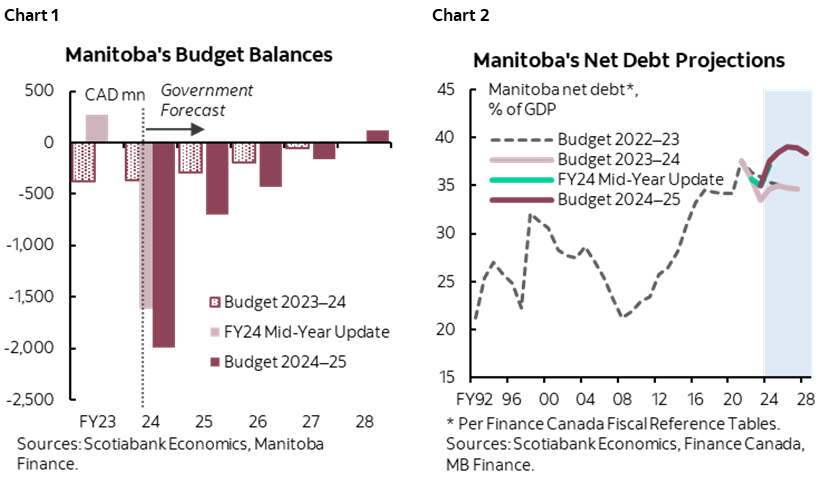
OUR TAKE
Manitoba’s NDP government tabled its first budget, outlining a renewed trajectory to balance with shrinking deficits through FY28. Following a deeper deficit revealed in its fall fiscal update (-$1.6 bn or -1.8% of nominal GDP in FY24), Manitoba’s Budget 2024 anticipates a revenue boost from provincial and federal sources, along with limited new spending, to slash the deficit to -$796 mn (-0.9% of GDP) in FY25. In the medium term, the province aims to cap spending growth (+2.3%) well below revenue growth (+3.5%) and reduce the shortfall by an average of $270 mn per year, achieving a small surplus in FY28.
Despite a slowing growth outlook, revenue projections were raised to a higher trajectory than previously anticipated. The province expects to receive $960 mn more in FY25 revenue than projected in its previous budget, representing a 9.1% jump from FY24 revenue, mainly driven by federal transfers. Federal transfers—typically accounting for one-quarter of total revenue in years preceding to the pandemic—are expected to contribute to a record share of 35.5% in FY25 due to increased equalization payments and remain an important source of income over the planning horizon at around 34%. Tax measures introduced in the budget—particularly the changes to education tax rebates—have a positive impact on revenue, offsetting the negative impact of the gas tax cut extension. Income from Manitoba Hydro and Manitoba Public Insurance Corporation remains a weak spot of revenue outlook.
New tax measures introduced in the budget are incremental and targeted with a focus on affordability. The budget incorporates a major change to school tax measures, replacing them with a more progressive Homeowners Affordability Tax Credit with a positive impact on revenue of $71 mn in FY25. In addition to an extension of the gas-tax holiday that saves Manitobans $85 mn in FY25, the budget also enhances the Renters Tax Credit and Fertility Treatment Tax Credit, as well as introducing a rebate for EVs.
Growth assumptions underpinning the Budget appear realistic and well-supported by the province’s diversified economy. The Budget accounts for a delayed slowdown with real GDP growth assumed at 1.4% in 2023 and 0.6% in 2024—largely in line with our current projections of 1.2% and 1.0%. The province prudently allocates $100 mn annually as contingencies over the planning horizon to ensure preparedness for a deeper slowdown.
The province continues to ramp up program spending in priority areas like health care and education, but keeps the pace within the bounds of revenue growth (chart 3). Building on the 7.8% increase in FY24, total expenses are projected to grow further by 2.8% in FY25. The government continues to boost funding to health, seniors and long-term care since its fall update with $309.5 mn additional investment to recruit healthcare workers, reduce wait times, and increase critical care capacity. The government also increased funding for schools and housing programs. Debt service costs are expected to increase by $113 mn due to higher interest rates on major capital projects initiated in FY24, accounting for 9.7% of revenue in FY25.
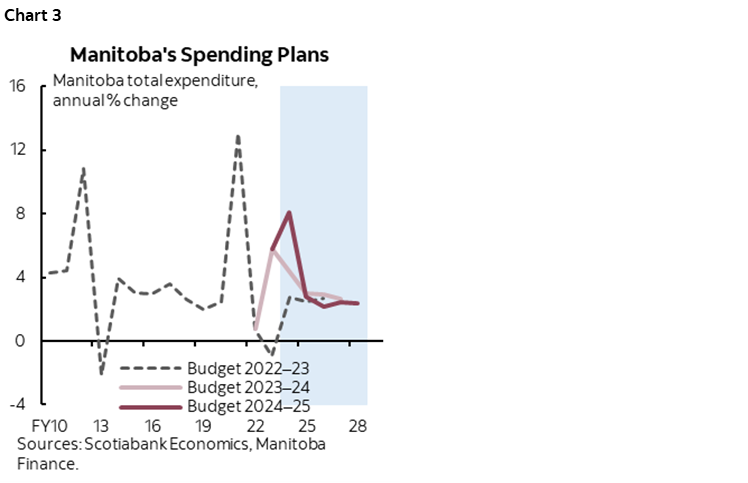
Manitoba continues to enhance its capital plan, dedicating an average of $3.1 bn each year over the next five years to infrastructure investment—11% higher than last budget’s plan (chart 4). Among the $3.1 bn planned outlays in FY25, $635 mn will go towards health capital investments, more than doubling the funding in the last plan.
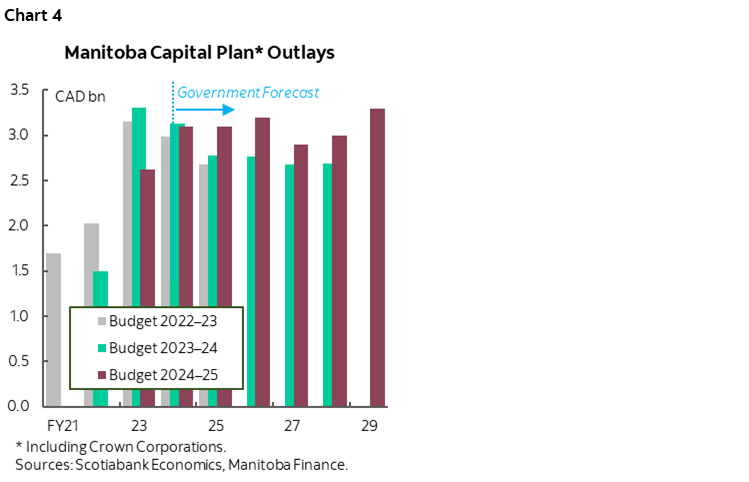
Manitoba’s borrowing requirements are expected to expand to total $6.2 bn in FY25. Of this amount, $3.5 bn will be allocated towards refinancing purposes in FY25, and $2.9 bn will be pre-funding for FY26. Approximately $2.7 bn of funding for FY25 had been pre-borrowed. Borrowing requirements are expected to decline to $5.8 bn in FY26 and $4.7 bn in FY27 as new cash requirements decrease by half, before picking up to $5.7 bn in FY28 with higher refinancing needs. Mirroring the projected increase in deficit and heightened costs in capital projects, net debt is tracking 3.5 ppts higher as a share of output at 38.5% in FY25, up from 37.5% in FY24. Manitoba remains the fourth highest province in debt burden.
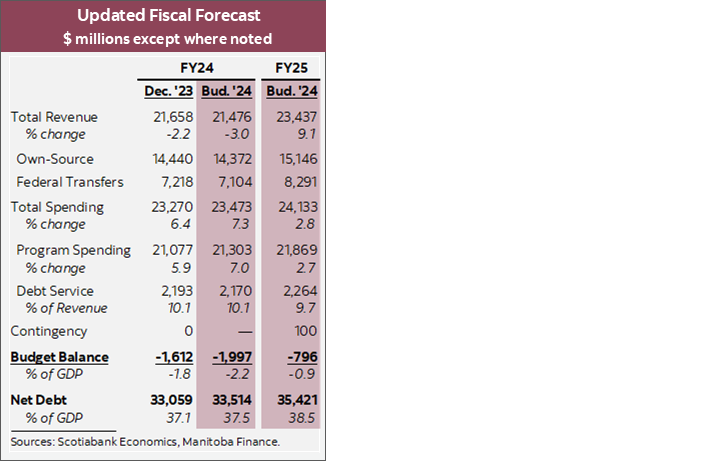
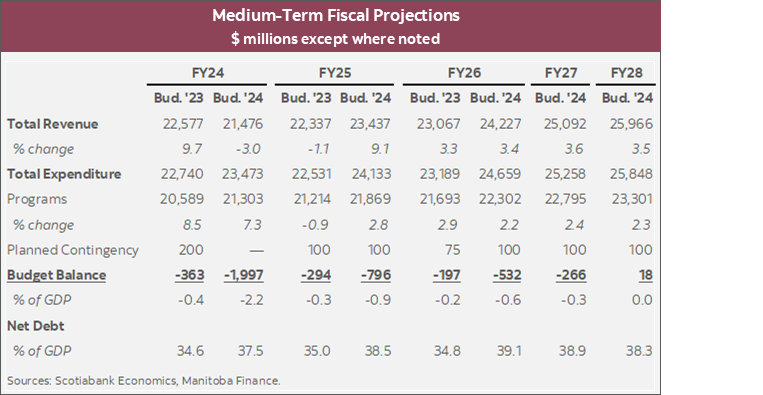
DISCLAIMER
This report has been prepared by Scotiabank Economics as a resource for the clients of Scotiabank. Opinions, estimates and projections contained herein are our own as of the date hereof and are subject to change without notice. The information and opinions contained herein have been compiled or arrived at from sources believed reliable but no representation or warranty, express or implied, is made as to their accuracy or completeness. Neither Scotiabank nor any of its officers, directors, partners, employees or affiliates accepts any liability whatsoever for any direct or consequential loss arising from any use of this report or its contents.
These reports are provided to you for informational purposes only. This report is not, and is not constructed as, an offer to sell or solicitation of any offer to buy any financial instrument, nor shall this report be construed as an opinion as to whether you should enter into any swap or trading strategy involving a swap or any other transaction. The information contained in this report is not intended to be, and does not constitute, a recommendation of a swap or trading strategy involving a swap within the meaning of U.S. Commodity Futures Trading Commission Regulation 23.434 and Appendix A thereto. This material is not intended to be individually tailored to your needs or characteristics and should not be viewed as a “call to action” or suggestion that you enter into a swap or trading strategy involving a swap or any other transaction. Scotiabank may engage in transactions in a manner inconsistent with the views discussed this report and may have positions, or be in the process of acquiring or disposing of positions, referred to in this report.
Scotiabank, its affiliates and any of their respective officers, directors and employees may from time to time take positions in currencies, act as managers, co-managers or underwriters of a public offering or act as principals or agents, deal in, own or act as market makers or advisors, brokers or commercial and/or investment bankers in relation to securities or related derivatives. As a result of these actions, Scotiabank may receive remuneration. All Scotiabank products and services are subject to the terms of applicable agreements and local regulations. Officers, directors and employees of Scotiabank and its affiliates may serve as directors of corporations.
Any securities discussed in this report may not be suitable for all investors. Scotiabank recommends that investors independently evaluate any issuer and security discussed in this report, and consult with any advisors they deem necessary prior to making any investment.
This report and all information, opinions and conclusions contained in it are protected by copyright. This information may not be reproduced without the prior express written consent of Scotiabank.
™ Trademark of The Bank of Nova Scotia. Used under license, where applicable.
Scotiabank, together with “Global Banking and Markets”, is a marketing name for the global corporate and investment banking and capital markets businesses of The Bank of Nova Scotia and certain of its affiliates in the countries where they operate, including; Scotiabank Europe plc; Scotiabank (Ireland) Designated Activity Company; Scotiabank Inverlat S.A., Institución de Banca Múltiple, Grupo Financiero Scotiabank Inverlat, Scotia Inverlat Casa de Bolsa, S.A. de C.V., Grupo Financiero Scotiabank Inverlat, Scotia Inverlat Derivados S.A. de C.V. – all members of the Scotiabank group and authorized users of the Scotiabank mark. The Bank of Nova Scotia is incorporated in Canada with limited liability and is authorised and regulated by the Office of the Superintendent of Financial Institutions Canada. The Bank of Nova Scotia is authorized by the UK Prudential Regulation Authority and is subject to regulation by the UK Financial Conduct Authority and limited regulation by the UK Prudential Regulation Authority. Details about the extent of The Bank of Nova Scotia's regulation by the UK Prudential Regulation Authority are available from us on request. Scotiabank Europe plc is authorized by the UK Prudential Regulation Authority and regulated by the UK Financial Conduct Authority and the UK Prudential Regulation Authority.
Scotiabank Inverlat, S.A., Scotia Inverlat Casa de Bolsa, S.A. de C.V, Grupo Financiero Scotiabank Inverlat, and Scotia Inverlat Derivados, S.A. de C.V., are each authorized and regulated by the Mexican financial authorities.
Not all products and services are offered in all jurisdictions. Services described are available in jurisdictions where permitted by law.

